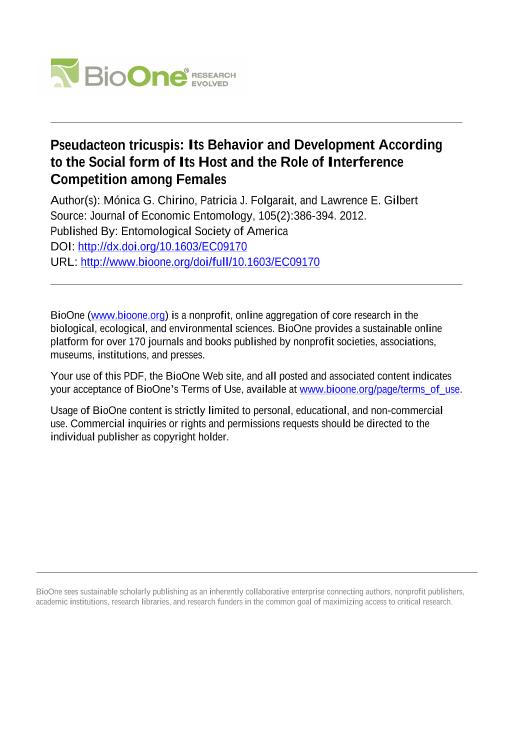Mostrar el registro sencillo del ítem
dc.contributor.author
Chirino, Monica Gabriela

dc.contributor.author
Folgarait, Patricia Julia

dc.contributor.author
Gilbert, Lawrence E.
dc.date.available
2023-04-26T15:24:12Z
dc.date.issued
2012-04
dc.identifier.citation
Chirino, Monica Gabriela; Folgarait, Patricia Julia; Gilbert, Lawrence E.; Pseudacteon tricuspis: Its behavior and development according to the social form of its host and the role of interference competition among females; Entomological Society of America; Journal of Economic Entomology; 105; 2; 4-2012; 386-394
dc.identifier.issn
0022-0493
dc.identifier.uri
http://hdl.handle.net/11336/195443
dc.description.abstract
We studied how the behavior and performance of Pseudacteon tricuspis Borgmeier varies with the social form of its host Solenopsis invicta Buren, in its native range in Argentina where monogyne colonies are more abundant than polygynes (≈75 vs. 25%). Female, P. tricuspis took 44% less time (50 vs. 89 s) to attack monogyne than polygyne ants, but oviposition attempts were similar (23 vs. 18 attacks). The presence of the parasitoid affected the average size of foragers on the trail, with the proportion of minor workers increasing on both social forms. In the laboratory, P. tricuspis selected similar host sizes, although pupal survival was 25% higher on monogynes than on polygynes. Developmental times of both genders were similar (3335 d), although larger females emerged from bigger hosts. The sex ratio of P. tricuspis was more male biased when exploiting polygyne ants. Intraspecific competition significantly affected parasitoid reproductive success, being significantly higher for a solitary female than when three females were present, although the size of workers selected did not vary. The male:female ratio also changed, being 1:1 without competition but 2:1 with competition. We demonstrated for the first time the consequences of interference competition among P. tricuspis females, a common behavior observed in others parasitoids. We discuss why P. tricuspis sex ratios are always biased toward males in both social forms and suggest that similar studies of interference competition within and between already naturalized Pseudacteon species in the United States could help predict establishment patterns.
dc.format
application/pdf
dc.language.iso
eng
dc.publisher
Entomological Society of America

dc.rights
info:eu-repo/semantics/openAccess
dc.rights.uri
https://creativecommons.org/licenses/by-nc-sa/2.5/ar/
dc.subject
BIOLOGICAL CONTROL
dc.subject
INTERFERENCE COMPETITION
dc.subject
PSEUDACTEON TRICUSPIS
dc.subject
SEX RATIO
dc.subject
SOCIAL FORM
dc.subject.classification
Zoología, Ornitología, Entomología, Etología

dc.subject.classification
Ciencias Biológicas

dc.subject.classification
CIENCIAS NATURALES Y EXACTAS

dc.title
Pseudacteon tricuspis: Its behavior and development according to the social form of its host and the role of interference competition among females
dc.type
info:eu-repo/semantics/article
dc.type
info:ar-repo/semantics/artículo
dc.type
info:eu-repo/semantics/publishedVersion
dc.date.updated
2023-04-26T10:46:33Z
dc.journal.volume
105
dc.journal.number
2
dc.journal.pagination
386-394
dc.journal.pais
Estados Unidos

dc.journal.ciudad
Lanham
dc.description.fil
Fil: Chirino, Monica Gabriela. Consejo Nacional de Investigaciones Científicas y Técnicas; Argentina. Universidad Nacional de Quilmes. Centro de Estudios e Investigación; Argentina
dc.description.fil
Fil: Folgarait, Patricia Julia. Consejo Nacional de Investigaciones Científicas y Técnicas; Argentina. Universidad Nacional de Quilmes. Centro de Estudios e Investigación; Argentina
dc.description.fil
Fil: Gilbert, Lawrence E.. University of Texas at Austin; Estados Unidos
dc.journal.title
Journal of Economic Entomology

dc.relation.alternativeid
info:eu-repo/semantics/altIdentifier/url/https://academic.oup.com/jee/article/105/2/386/893506
dc.relation.alternativeid
info:eu-repo/semantics/altIdentifier/doi/http://dx.doi.org/10.1603/EC09170
Archivos asociados
